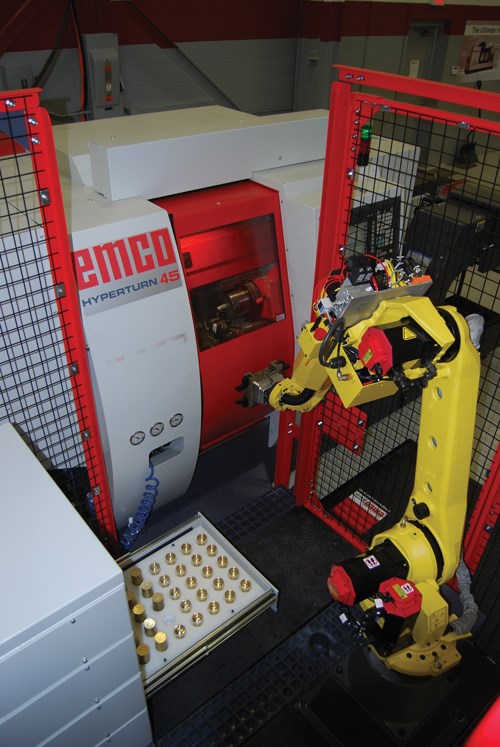Modular Automation Package for Turning Machines
Here's a modular robotic automation cell for cost-effective, flexible part load/unload of turning machines.
#Industry40
Machine shops of all sizes continue to seek ways to automate what they do to improve consistency, save time and reduce cost per piece produced. In response to that need, Emco Maier has partnered with UltraTech Machinery, Cuyahoga Falls, Ohio, to offer a modular robotic automation cell that provides cost-effective, flexible part load/unload for the Emco Maier line of turning machines.
The new package was demonstrated recently with an HT45 SMY universal production turning machine—a versatile, multitasking production turn-mill center designed for a range of applications on barstock to 45-mm diameter. The Hyperturn 45 includes high-performance main and counter spindles, two tool systems with as many as 24 driven tools, and a stable Y axis with a 70-mm travel in the upper slide system and a Z2 axis in the lower slide system.
Featured Content
Teamwork
Philipp Hauser, Emco Maier USA president, says, “The integration partnership with UltraTech is a positive for us and our customers. About 10 months ago, we saw more and more sales activity and RFQs for turnkeys and automation. One of our strategies was to find a local U.S. partner, especially for robot integration. Having Motch & Eichele, a partner company of UltraTech, as one of our large dealers, it was clear we should work with UltraTech to develop a solution.”
According to Bob Hagarty, CEO of Motch & Eichele, “The challenge was to put a flexible handling solution around a compact turning machine that was also scalable to use with a larger machine. We developed a universal base with left- and right-hand versions configurable to the machine model. It is a production-proven solution with millions of open/close cycles.”
Named the Emco Factory Automation Solution, it is designed to be easily used in small shops as well as large plants. The overall package is non-threatening to machine operators. Often, the most challenging portion of an automation solution is part infeed and outfeed. The multi-drawer part cabinet offers a simple, flexible method to provide a useable buffer of oriented parts to the robot. The user is responsible only for part-specific gripper fingers and trays for the drawers, robot path point teaching and minor program modifications as needed for tray unload/load and machine unload/load.
“Since UltraTech’s heritage is in production, we knew what this solution would need to feature: machine tool construction, easy installation and use and high flexibility,” says Steve LaMarre, director, automation sales.
The fully integrated solution is based on the FANUC M-20iA robot, which has a relatively small footprint, yet heavy payload and good reach, providing a variety of machine use options, the company says.
“Our decision to develop this solution has been confirmed by recent industry surveys that indicate that automation is becoming increasingly important to our customer industries,” Mr. Hauser says. “The automation package offers a favorable capability/benefit versus cost and can be delivered quickly.”
Highlights
Robust part drawers with heavy-duty drawer slides have a weight capacity of 300 pounds and can accommodate parts as tall as 6 inches in a useable area of 18 inches by 24 inches. Actual part quantity is dependent on the locating trays supplied by the customer. The robot has a 44-pound payload with 30-pounds available for customer-supplied finger details and part weight. Load/unload times are application dependent, but 6 to 8 seconds has been demonstrated.
“Our solution uses I/O blocks and cables, so it is literally plug and play,” Mr. LaMarre says. “Plus, it includes a secure workpiece storage/service drawer mounted on the platform that can be safely accessed by the operator, while the robot can access other drawers at the same time.”
All equipment is mounted on a common base plate with forklift pockets. The base has drip pan and walk-on grating under which all robot cables and interconnect wiring are concealed and protected. Simple installation consists of locating the system in front of the machine
tool within robot reach, leveling the base using the included screws, and lagging the base to the plant floor. The base package is completely assembled and fully tested prior to shipment.
The compact solution is designed to allow shops, even with no automation experience, to install without the help of a third party automation house. Users can select end-of-arm tooling from two gripper models and three different mounting configurations, based on the workpieces’ geometry and weight. Software options simplify programming, assist in safer operation, and help to protect the equipment from damage from improper programming. The user has complete access to the machine controller without interrupting robot operation, including unrestricted access for setup and tool changes.
RELATED CONTENT
-
What Is The Best Bar Feed System For Production Turning?
Selecting the right bar feeder can be one of the most important decisions a shop can make. Bar feed systems help improve productivity, throughput and quality, but in order to achieve the most benefit from them it is essential that a bar feed system be matched to the particular needs of the turning operation.
-
Bar Feeder Basics
Some primary factors are often overlooked when considering how to justify the implementation of a bar feeder for turning operations.
-
The Many Sides of Workholding
Here's a broad look at different ways to approach workholding, from bar feeders to collet chucks to robotics.








